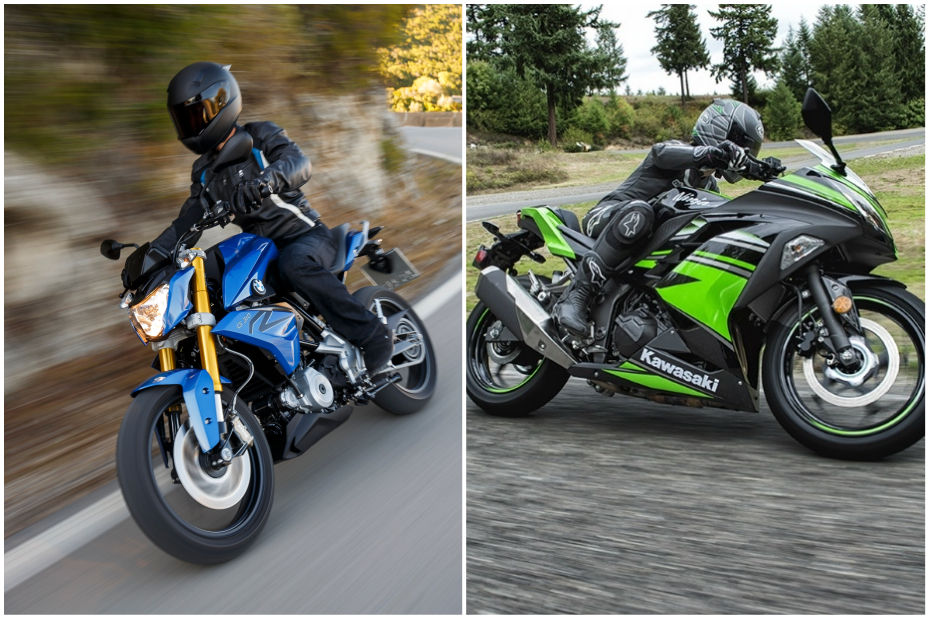BMW G 310 R Vs Kawasaki Ninja 300 - Which One Suits You Best.
Modified On Mar 20, 2019 01:29 PM By Gaurav Sadanand for BMW G 310 R
- 9937 Views
- Write a comment
We find out how the single-cylinder bike fares against its refined twin cylinder-powered counterpart in the same price bracket

The BMW G 310 R, launched at a price of Rs 2.99 lakh, now competes directly with the locally assembled Kawasaki Ninja 300. We find out which one of the two makes for a better proposition.
Design

The BMW G 310 Roadster, designed after its elder sibling, the S 1000 R, sports minimal bodywork which will prove to be relatively inexpensive to repair in case of a fall. The paint quality, fit and finish of the roadster are typical BMW standards, by which we mean top notch. Although the absence of a fairing means the rider has to tackle wind blasts which strains the neck on long rides. The street focused G 310 R’s slightly rear-set footpegs with wide handlebars translates to an upright and comfortable riding posture.

On the contrary, the Ninja 300 bears a full fairing which not only cuts through strong winds but also makes it look a lot sportier. And the striking Kawasaki Green paintjob adds to the persona of the bike. The downside is that the design, being a couple of years old, looks dated. Also, now that the Ninja 300 is locally manufactured, the fit and finish of the bike feels substandard, at least visually, owing to the panel gaps. The Ninja 300’s clip-on handlebars are set forward and low, while the footpegs are positioned high and mildly rear-set. This makes for a riding position that’s comfortable for daily use, yet allows you to move your body around during cornering.
Features

On the features front, the Roadster sports an all-digital instrument console which reads the essentials - speedometer, tachometer, trip meter, odometer, fuel gauge, gear indicator and a service indicator. Lighting the way at night is a halogen bulb up front and an all-LED tail light unit at the rear. It employs a smaller 11-litre fuel tank compared to the larger 17 litres available on the Ninja 300. That said, you can expect better fuel efficiency from the single cylinder.

Though the semi-digital instrument console might appeal to most people, the information available on the Ninja's speedo feels dated. The bike uses conventional halogen bulbs in the front and a single bulb at the rear. With a large 17-litre fuel tank, expect a range of around 530km.
Engine

The BMW’s unique reverse-inclined engine helps in better mass centralisation, improved inflow and outflow of air which in turn keeps the engine cool at all times. The engine though is quite vibey, which can be felt through the handlebar, footpegs and body panels. Expect the BMW G 310 R to be quite similar to the RR 310 in terms of engine character; however, the German counterpart would be a lot more refined. The G 310 R is said to be most happy in the mid-range and kicks in slightly sooner compared to the RR 310.

The refinement on the Japanese twin-cylinder is second to none. Moreover, it is assisted with a slipper clutch which makes for easy downshifts and prevents wheel hopping, something that the BMW misses out on. The power is concentrated towards the top of the rev band, with serious performance kicking in post 9,000 rpm. Heat dissipation is another big plus as it's directed to the bottom of the bike and away from the rider, keeping the engine and the rider cool.
Mechanical components

Since the G 310 R uses the same tubeless steel frame with a bolted sub-frame as the RR 310, we can expect the handling to be quite good. Suspension duties are handled by 41mm upside-down forks up front and a monoshock at the rear, which is said to improve the responsiveness of the bike compared to the Ninja’s conventional forks. Expect progressive braking and a decent bite from the Bybre units employed in the G 310 R. The Michelins that come as standard offers better grip.

The Kawasaki uses a diamond type steel frame with conventional front forks and a monoshock at the rear which is set up on the stiffer side. Despite the stiffer setup, the suspension manages to soak up most imperfections. Brakes on the Ninja offers progressive bite. The Thai-made IRC tyres have been replaced with MRF Zappers, the same ones seen on the pre-update Yamaha R3 which weren’t up to standards. A stickier set of premium tyres, at least as an option, would have been nice. ABS comes as standard on both bikes.
Price and verdict

All things considered, the Kawasaki Ninja priced at Rs 2.98 lakh offers a tad more in terms of value for money. However, if you're looking for high levels of fit and finish and the BMW badge, the G 310 R priced at Rs 2.99 lakh (both ex-showroom) makes for a good proposition. Both the manufacturers offer 3 years of warranty and unlimited kilometres.
